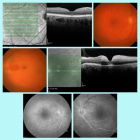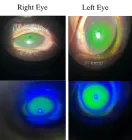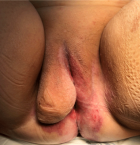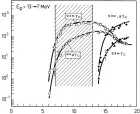Abstract
Case Report
CT-guided Retrograde Urography as a Diagnostic Tool for Post-kidney Transplantation Evaluation: A Case Report
Han-Mei Chang, Chan-I Su and Ching-Ting Chang*
Published: 04 September, 2023 | Volume 7 - Issue 1 | Pages: 004-006
The vast majority of urological complications occur at the ureterovesical junction and usually occur early after transplantation. The aim of this study is to enhance the quality of medical care provided to patients who undergo kidney transplantation. Cystography was conducted on renal transplant recipients utilizing computed tomography. The utilization of changes in the patient’s position and reconstructed images of the bladder can serve as a diagnostic tool to assess the normal functioning of the urinary tract system subsequent to kidney transplantation. To ensure adequate filling of the bladder and ureter, it is necessary to introduce varying amounts of contrast medium through the urinary catheter into these structures. This diagnostic procedure aims to verify the existence of stenosis or leakage occurring at the vesicoureteral junction. The evaluation and diagnosis of urinary tract problems subsequent to kidney transplantation can be effectively conducted. Furthermore, it has the potential to mitigate the adverse effects and alleviate the strain on the renal system resulting from the administration of contrast agents in computed tomography urography. CT-guided cystography can enhance the medical quality and comfort of Kidney transplantation patients.
Read Full Article HTML DOI: 10.29328/journal.jcmei.1001028 Cite this Article Read Full Article PDF
Keywords:
Kidney transplantation; Major urologic complications; Computed tomography urography
References
- Kumar S, Ameli-Renani S, Hakim A, Jeon JH, Shrivastava S, Patel U. Ureteral obstruction following renal transplantation: causes, diagnosis and management. Br J Radiol. 2014 Dec;87(1044):20140169. doi: 10.1259/bjr.20140169. Epub 2014 Oct 6. PMID: 25284426; PMCID: PMC4243200.
- Nino-Torres L, Garcia-Lopez A, Patino-Jaramillo N, Giron-Luque F, Nino-Murcia A. Risk Factors for Urologic Complications After Kidney Transplantation and Impact in Graft Survival. Res Rep Urol. 2022 Sep 28;14:327-337. doi: 10.2147/RRU.S371851. PMID: 36196091; PMCID: PMC9527029.
- Gupta R, Woo K, Yi JA. Epidemiology of end-stage kidney disease. Semin Vasc Surg. 2021 Mar;34(1):71-78. doi: 10.1053/j.semvascsurg.2021.02.010. Epub 2021 Feb 4. PMID: 33757639; PMCID: PMC8177747.
- Duty BD, Barry JM. Diagnosis and management of ureteral complications following renal transplantation. Asian J Urol. 2015 Oct;2(4):202-207. doi: 10.1016/j.ajur.2015.08.002. Epub 2015 Aug 24. PMID: 29264146; PMCID: PMC5730752.
- Nie Z, Zhang K, Huo W, Li Q, Zhu F, Jin F. Comparison of urological complications with primary ureteroureterostomy versus conventional ureteroneocystostomy. Clin Transplant. 2010 Sep-Oct;24(5):615-9. doi: 10.1111/j.1399-0012.2009.01134.x. PMID: 19925475.
- Bruintjes MHD, d'Ancona FCH, Zhu X, Hoitsma AJ, Warlé MC. An Update on Early Urological Complications in Kidney Transplantation: A National Cohort Study. Ann Transplant. 2019 Dec 3;24:617-624. doi: 10.12659/AOT.920086. PMID: 31792196; PMCID: PMC6909919.
- Sarıer M, Duman İ, Demir M, Yüksel Y, Emek M, Kukul E. The outcomes of transurethral incision/resection of the prostate (TUIP/TURP) performed early after renal transplantation. Turk J Urol. 2018 Mar;44(2):172-177. doi: 10.5152/tud.2018.98404. Epub 2018 Mar 1. PMID: 29511589; PMCID: PMC5832381.
- Ostrowski M, Włodarczyk Z, Wesołowski T, Gracz H, Sluzar T, Sieńko J, Lubikowski J, Bohatyrewicz R. Influence of ureterovesical anastomosis technique on the incidence of vesicoureteral reflux in renal transplant recipients. Ann Transplant. 1999;4(1):54-8. PMID: 10850602.
- Rahnemai-Azar AA, Gilchrist BF, Kayler LK. Independent risk factors for early urologic complications after kidney transplantation. Clin Transplant. 2015 May;29(5):403-8. doi: 10.1111/ctr.12530. Epub 2015 Mar 6. PMID: 25683841.
- Sarier M, Yayar O, Yavuz A, Turgut H, Kukul E. Update on the Management of Urological Problems Following Kidney Transplantation. Urol Int. 2021;105(7-8):541-547. doi: 10.1159/000512885. Epub 2021 Jan 28. PMID: 33508852.
- Gökçe AM, Kaya C, Kara VM, Ozel L, Ruhi C, Titiz MI. Effects of Urethral Stricture on Allografts in Kidney Transplantation. Transplant Proc. 2015 Jun;47(5):1336-9. doi: 10.1016/j.transproceed.2015.04.072. PMID: 26093713.
- Engelsgjerd JS, Deibert CM. Cystoscopy. 2023 Apr 10. In: StatPearls [Internet]. Treasure Island (FL): StatPearls Publishing; 2023 Jan–. PMID: 29630232.
- Ellerkmann RM, Dunn JS, McBride AW, Kummer LG, Melick CF, Bent AE, Blomquist JL. A comparison of anticipated pain before and pain rating after the procedure in patients who undergo cystourethroscopy. Am J Obstet Gynecol. 2003 Jul;189(1):66-9. doi: 10.1067/mob.2003.377. PMID: 12861140.
- Park MS, Ha HI, Ahn JH, Lee IJ, Lim HK. Reducing contrast-agent volume and radiation dose in CT with 90-kVp tube voltage, high tube current modulation, and advanced iteration algorithm. PLoS One. 2023 Jun 15;18(6):e0287214. doi: 10.1371/journal.pone.0287214. PMID: 37319309; PMCID: PMC10270572.
- Davenport MS, Khalatbari S, Dillman JR, Cohan RH, Caoili EM, Ellis JH. Contrast material-induced nephrotoxicity and intravenous low-osmolality iodinated contrast material. Radiology. 2013 Apr;267(1):94-105. doi: 10.1148/radiol.12121394. Epub 2013 Jan 29. PMID: 23360737; PMCID: PMC3606541.
Figures:

Figure 1

Figure 2

Figure 3

Figure 4

Figure 5
Similar Articles
-
CT-guided Retrograde Urography as a Diagnostic Tool for Post-kidney Transplantation Evaluation: A Case ReportHan-Mei Chang, Chan-I Su, Ching-Ting Chang*. CT-guided Retrograde Urography as a Diagnostic Tool for Post-kidney Transplantation Evaluation: A Case Report. . 2023 doi: 10.29328/journal.jcmei.1001028; 7: 004-006
Recently Viewed
-
Optimizing Treatment of Depression, Trauma, and Anxiety Disorders through Neurophysiological InterventionsKees Blasé*. Optimizing Treatment of Depression, Trauma, and Anxiety Disorders through Neurophysiological Interventions. Insights Depress Anxiety. 2025: doi: 10.29328/journal.ida.1001046; 9: 027-029
-
Investigating the Effect of the Family-Centered Empowerment Model (FCEM) on the Empowerment Indicators of Student Girls with Iron Deficiency Anemia (IDA) and Their MothersFatemeh Alhani,Hasan Navipor,Fatemeh Sadat Seyed Nematollah Roshan*. Investigating the Effect of the Family-Centered Empowerment Model (FCEM) on the Empowerment Indicators of Student Girls with Iron Deficiency Anemia (IDA) and Their Mothers. Insights Depress Anxiety. 2025: doi: 10.29328/journal.ida.1001045; 9: 017-024
-
The Bacteriological Profile of Nosocomial Infections at the Army Central Hospital of BrazzavilleMedard Amona*,Yolande Voumbo Matoumona Mavoungou,Hama Nemet Ondzotto,Benjamin Kokolo,Armel Itoua,Gilius Axel Aloumba,Pascal Ibata. The Bacteriological Profile of Nosocomial Infections at the Army Central Hospital of Brazzaville. Int J Clin Microbiol Biochem Technol. 2025: doi: 10.29328/journal.ijcmbt.1001032; 8: 009-022
-
Examining the Effects of High Poverty and Unemployment on Rural Urban Migration in Nigeria and its Consequences on Urban Resources and Rural DeclineTochukwu S Ezeudu*, Bilyaminu Tukur. Examining the Effects of High Poverty and Unemployment on Rural Urban Migration in Nigeria and its Consequences on Urban Resources and Rural Decline. J Child Adult Vaccines Immunol. 2024: doi: 10.29328/journal.jcavi.1001012; 8: 001-013
-
Endogenus toxicology: Modern physio-pathological aspects and relationship with new therapeutic strategies. An integrative discipline incorporating concepts from different research discipline like Biochemistry, Pharmacology and ToxicologyLuisetto M*,Naseer Almukhtar,Behzad Nili Ahmadabadi,Gamal Abdul Hamid,Ghulam Rasool Mashori,Kausar Rehman Khan,Farhan Ahmad Khan,Luca Cabianca. Endogenus toxicology: Modern physio-pathological aspects and relationship with new therapeutic strategies. An integrative discipline incorporating concepts from different research discipline like Biochemistry, Pharmacology and Toxicology . Arch Cancer Sci Ther. 2019: doi: 10.29328/journal.acst.1001004; 3: 001-024
Most Viewed
-
Impact of Latex Sensitization on Asthma and Rhinitis Progression: A Study at Abidjan-Cocody University Hospital - Côte d’Ivoire (Progression of Asthma and Rhinitis related to Latex Sensitization)Dasse Sery Romuald*, KL Siransy, N Koffi, RO Yeboah, EK Nguessan, HA Adou, VP Goran-Kouacou, AU Assi, JY Seri, S Moussa, D Oura, CL Memel, H Koya, E Atoukoula. Impact of Latex Sensitization on Asthma and Rhinitis Progression: A Study at Abidjan-Cocody University Hospital - Côte d’Ivoire (Progression of Asthma and Rhinitis related to Latex Sensitization). Arch Asthma Allergy Immunol. 2024 doi: 10.29328/journal.aaai.1001035; 8: 007-012
-
Causal Link between Human Blood Metabolites and Asthma: An Investigation Using Mendelian RandomizationYong-Qing Zhu, Xiao-Yan Meng, Jing-Hua Yang*. Causal Link between Human Blood Metabolites and Asthma: An Investigation Using Mendelian Randomization. Arch Asthma Allergy Immunol. 2023 doi: 10.29328/journal.aaai.1001032; 7: 012-022
-
An algorithm to safely manage oral food challenge in an office-based setting for children with multiple food allergiesNathalie Cottel,Aïcha Dieme,Véronique Orcel,Yannick Chantran,Mélisande Bourgoin-Heck,Jocelyne Just. An algorithm to safely manage oral food challenge in an office-based setting for children with multiple food allergies. Arch Asthma Allergy Immunol. 2021 doi: 10.29328/journal.aaai.1001027; 5: 030-037
-
Snow white: an allergic girl?Oreste Vittore Brenna*. Snow white: an allergic girl?. Arch Asthma Allergy Immunol. 2022 doi: 10.29328/journal.aaai.1001029; 6: 001-002
-
Cytokine intoxication as a model of cell apoptosis and predict of schizophrenia - like affective disordersElena Viktorovna Drozdova*. Cytokine intoxication as a model of cell apoptosis and predict of schizophrenia - like affective disorders. Arch Asthma Allergy Immunol. 2021 doi: 10.29328/journal.aaai.1001028; 5: 038-040

If you are already a member of our network and need to keep track of any developments regarding a question you have already submitted, click "take me to my Query."


















































































































































